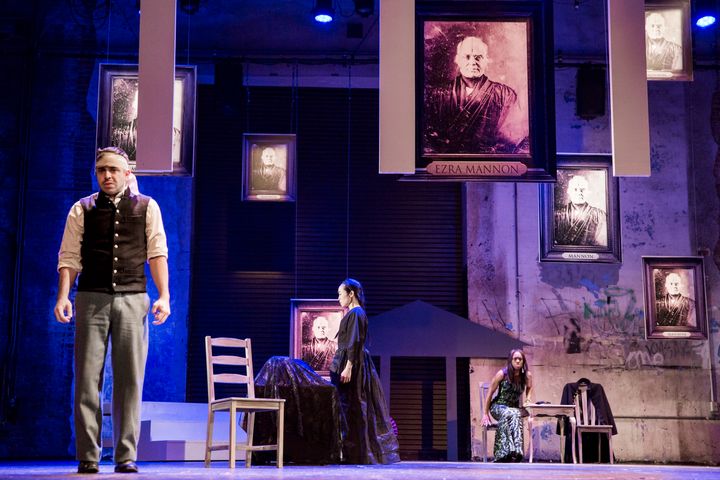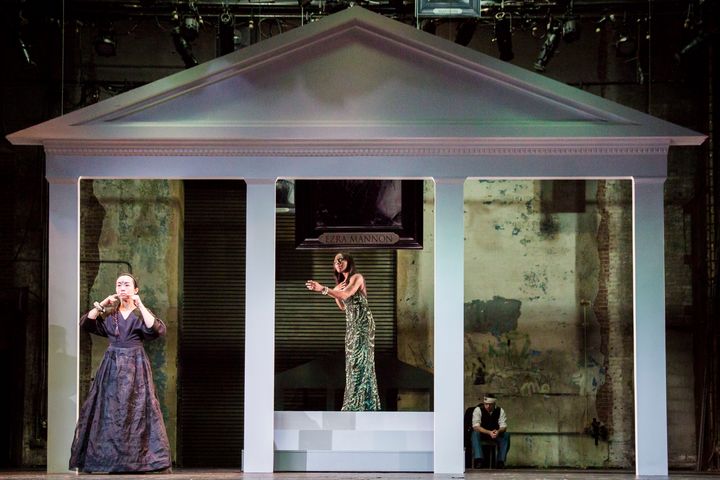
Satya Bhabha, Eunice Wong and Stephanie Weeks in Target Margin Theater’s Mourning Becomes Electra. Directed by David Herskovits.
On a beautiful day in Sunset Park, just off a street that could be a set for many Eugene O’Neill and Arthur Miller plays, I sat on a stool chatting with Founder and Artistic Director David Herskovits about Target Margin Theater’s upcoming show, which he is directing. TMT is staging the entire Mourning Becomes Electra trilogy in a marathon six-hour production that has been two years in the making. As most of you know, I have seen TMT’s work for years, and even worked as one of the Lead Artists in their “Unseen O’Neill Lab” this past year. In other words, I am a fan of this company – not only for the very creative, bold, and conceptually fascinating work they produce, but also for the intelligence and vision that exists behind the scenes. Though the former is immediately obvious from an audience perspective, I’m hoping to share a bit of the latter with you today.
As we chatted about O’Neill in general, and these works in particular, I asked Herskovits about how he thinks about the particular challenges of a series of plays that are “O’Neillian” in tone, but Greek in scale. He said, “It’s all about opening up the many, many different textures that are present in this document, and trying to celebrate and honor each of them and have them all play together, rather than ironing them out into one thing.” When I asked him to explain the various aspects of the work as he saw it, he elaborated,
The play is written like a melodrama. It’s structured that way. Some of the dialogue is very melodramatic. There are passages where it feels like every line has an exclamation mark at the end of it – every sentence in every line has an exclamation mark. There are gasps. There are stage directions that indicate steamy looks, lip quivering, hand-wringing, stuff like that. And then there is some writing that is very quiet and internal and mysterious, that’s clearly a writer trying to bringing a depth of psychology onto the stage in a real way, in the ‘30s, when that wave of analysis and thinking about what people are inside was really sweeping across our country. And then, on the other hand, it’s a Greek tragedy. And there are elements where he indicates very clearly a kind of formality, a sort of formalism, a kind of stylization, that’s clearly Greek: the masks, a stiffness of gesture, the temple front, and so on, where he’s trying to write that play. And then, it’s an American history play. Abe Lincoln is killed and the war is ending, and the guy is talking about the war and freeing the slaves – all of that is in the play and is, in a certain way, present to the people as a real lived part of the story. And also metaphorically, in the sense in which the house that we see is the house of Atreus and it’s also the house of the United States of America – it’s the corrupt edifice of our nation at a crucial moment of an attempt to rebuild it. All of that is present. And more. So I want to hear all of those elements of the text and hear the text in all of those ways. I believe that we can find a way to modulate between all those different voices and create the particular kind of music that is unique to this play.
Having seen two of the individually presented portions of this work over the years – Durned Queer and Drunken with What, both of which take their titles from lines in those plays – I will say that TMT’s productions of this work have an incredible way of playing into the style of the text while still remaining grounded. This allows the actors to take the audience through O’Neill’s sometimes overwrought writing in a way that corrects for those highly stylized portions so often accused of being bad writing, creating an environment where the text speaks in a very distinct way. As Herskovits says, “Despite all of the very intricate theatricality being deployed in this production, for me personally, one of the core motivations of everything is simply to hear the language. Just hear it. And re-hear it freshly, hear it anew.” In my experience, that is precisely what TMT’s productions are able to accomplish.

Eunice Wong, Stephanie Weeks and Satya Bhabha.
Of course, I couldn’t have a discussion about Eugene O’Neill’s work without discussing stage directions. I was surprised to learn that there is a part of the rehearsal process where the strict to-the-letter version of the plays is performed. Herskovits detailed the rehearsal process for me, noting,
One of the things that we’ve done is we’ve gone through every scene and observed all of Eugene O’Neill’s stage directions. Every single one. Some of them are physical, and you just do the thing: sits, stands, whatever. But some of them are internal, and so you have to find a way to mark it. Or some of them are interpretative, and so you find a way to observe it so it makes sense to you. And we’ve created a version of the play that’s quite extreme in that way. And then having created that very exact, connect the dots kind of version of every scene, we then have gone back to it and done a version of the play that, in a way, is us remembering that other version of the play.
This ghosted, haunted quality of the movement is another one of my favorite things about the two previous versions of this work, and I look forward to seeing it on a larger scale.
Finally, I asked Herskovits what this play means to him at the present moment. Why do this play now? He answered,
I live this experience as three stories, primarily, that it “means to me,” I guess you could say: it’s the story of a family, it’s the story of our country, and it’s the story of the theatre. Then it’s also, working with all that, for me, it’s very selfish, I love the challenge and the joy of trying to bring those things present in the event, sustain them in a mysterious and engaging way, wrestle with the technical challenges of creating the work. And it gives me an opportunity to work on the kinds of things that I’m obsessed with artistically and theatrically: memory, history, presence and absence on stage. So, in a way, it gives me a very easy and natural canvas on which I can spread those things. Memory particularly has been the engine of a lot of my interest and my work in the theatre for some years now, and I think that this play is a new level of that.
I would agree. And is there anything you would like to tell the audience before they arrive? He replied, “The only thing I want of an audience is just a willingness to go along for the ride, and an openness to whatever it may be.” Your journey to Mourning Becomes Electra can begin right here, where you can purchase tickets to see the six-hour epic trilogy at The Abrons Arts Center, where your ticket buys you a pu-pu platter meal and snack. There are only 17 performances, beginning April 26th and ending on May 20th. Get your tickets fast to see this story of a family, our country, and the theatre before it’s too late!
